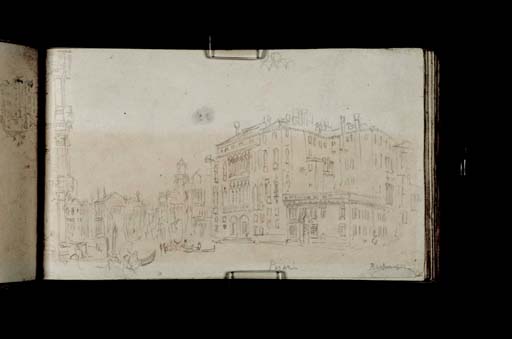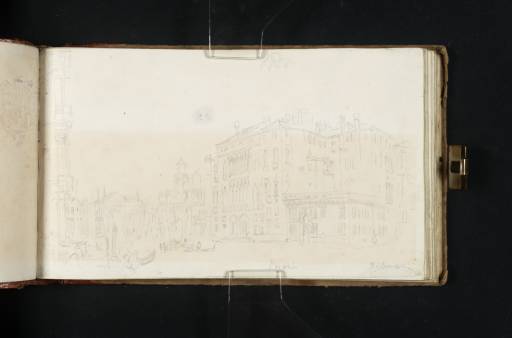Joseph Mallord William Turner The Grand Canal, Venice, with Palaces Including the Pisani Moretta and Barbarigo della Terrazza, and the Palazzo Balbi in the Distance 1819
Image 1 of 2
-
 Joseph Mallord William Turner, The Grand Canal, Venice, with Palaces Including the Pisani Moretta and Barbarigo della Terrazza, and the Palazzo Balbi in the Distance 1819
Joseph Mallord William Turner, The Grand Canal, Venice, with Palaces Including the Pisani Moretta and Barbarigo della Terrazza, and the Palazzo Balbi in the Distance 1819 -
 Joseph Mallord William Turner, The Grand Canal, Venice, with Palaces Including the Pisani Moretta and Barbarigo della Terrazza, and the Palazzo Balbi in the Distance 1819 (Enhanced image)Enhanced image
Joseph Mallord William Turner, The Grand Canal, Venice, with Palaces Including the Pisani Moretta and Barbarigo della Terrazza, and the Palazzo Balbi in the Distance 1819 (Enhanced image)Enhanced image
Joseph Mallord William Turner,
The Grand Canal, Venice, with Palaces Including the Pisani Moretta and Barbarigo della Terrazza, and the Palazzo Balbi in the Distance
1819
Joseph Mallord William Turner 1775–1851
Folio 72 Verso:
The Grand Canal, Venice, with Palaces Including the Pisani Moretta and Barbarigo della Terrazza, and the Palazzo Balbi in the Distance 1819
D14454
Turner Bequest CLXXV 72a
Turner Bequest CLXXV 72a
Pencil on white wove paper, 112 x 185 mm
Inscribed by Turner in pencil ‘Pisani’ bottom centre and ‘Barbarigo’ bottom right
Inscribed by Turner in pencil ‘Pisani’ bottom centre and ‘Barbarigo’ bottom right
Accepted by the nation as part of the Turner Bequest 1856
References
1909
A.J. Finberg, A Complete Inventory of the Drawings of the Turner Bequest, London 1909, vol.I, p.515, CLXXV 72a, as ‘Palazzo “Pisani” and “Barbarigo.”’.
1930
A.J. Finberg, In Venice with Turner, London 1930, pp.46, 166, as ‘Looking down the Grand Canal, with the Corner Spinelli on the left, the Barbarigo della Terrazza, Pisani, Tiepolo, and other palaces on the right. “Pisani”, “Barbarigo.”’.
1984
Martin Butlin and Evelyn Joll, The Paintings of J.M.W. Turner, revised ed., New Haven and London 1984, p.219 under no.368.
1984
Hardy George, ‘Turner in Europe in 1833’, Turner Studies, vol.4, no.1, Summer 1984, p.20 note 4.
1985
Lindsay Stainton, Turner’s Venice, London 1985, p.52 under no.36.
2001
Evelyn Joll, ‘Huntington Art Gallery’ in Joll, Martin Butlin and Luke Herrmann (eds.), The Oxford Companion to J.M.W. Turner, Oxford 2001, p.146.
2003
Ian Warrell in Warrell, David Laven, Jan Morris and others, Turner and Venice, exhibition catalogue, Tate Britain, London 2003, pp.158, 264 note 17.
The drawing is inverted relative to the sketchbook’s foliation. Finberg subsequently annotated his 1909 Inventory entry (‘Palazzo “Pisani” and “Barbarigo.”’): ‘Looking up [‘?down’ inserted above] the Grand Canal, with P. Corner Spinelli on left, and Pi Barbarigo della Terrazza, Pisani, Tiepolo, Persico & Balbi on right. (?Tower of S. Toma) from the To a S. Benedetto’1
Framing the view on the left are the pilasters on the corner of the east side of the Palazzo Corner Spinelli, with the twin obelisk finials of the Palazzo Balbi along the Grand Canal to the west-south-west in the distance. Dominating the right foreground on the north side of the canal are what Ian Warrell has described as ‘the most conspicuous of these petrified remains of Venetian wealth and ambition’,2 the adjacent Palazzi Pisani Moretta and Barbarigo della Terrazza, with the central attic window of the lower Palazzo Tiepolo to their left and what Finberg identified as the campanile of the church of San Tomà,3 no longer extant in that form, beyond. Finberg also noted the Palazzo Persico, which is identifiable just to the left of the campanile, but not drawn in any great detail from this distance. The detail at the top is from the elaborate second store window tracery of the Palazzo Pisani Moretta, with its intricate interlocking arches and quatrefoils.
Finberg thought Turner may have made have had recourse to a balcony on the south side of the canal, since ‘the line of sight is nearly level with the top of the Barbarigo terrace’,4 but the rest of the drawing suggests a low viewpoint typical of those made from the water or landing places on adjacent pages, and the somewhat disjointed perspective may have been the result of haste or a rocking boat.
Presumably owing to confusion over the sequence of pages extracted for display in the nineteenth century and later restored (see the technical notes in the sketchbook’s Introduction), the Turner Bequest number for this drawing was cited by Martin Butlin and Evelyn Joll in terms of its being used for the oil painting The Grand Canal, Venice, exhibited at the Royal Academy in 1837 (Huntington Library, Art Collections, and Botanical Gardens, San Marino, California),5 which shows the view in the opposite direction, towards the Rialto Bridge: ‘As Dr [Robert R.] Wark has shown, the picture is based on two pencil sketches in the ‘Milan to Venice’ sketchbook (CLXXV pp.72 verso and 73, although only part of the drawing on the left-hand page is used in the oil)’.6 The other page referred to, folio 73 recto opposite (D14455; Turner CLXXV 73), clearly a source for the painting, is the other way up and compositionally unrelated; its actual continuation, by an accident of rebinding, is now folio 74 recto (D14456), of which the relatively nondescript buildings left of the bridge in the distance presumably constitute ‘the only part ... used in the oil’; in fact, in the publication Butlin and Joll cited, Wark correctly reproduced both relevant pages without citing their folio numbers,7 so the issue arose subsequently.
Warrell has compared the view in the present drawing with those in a less refined pencil study in the 1833 Venice sketchbook (D32085; Turner Bequest CCCXIV 84a) and an 1840 watercolour (Tate D32213; Turner Bequest CCCXVII 28).8 For other drawings made in the vicinity and an overview of Turner’s coverage of Venice, see the sketchbook’s Introduction.
Undated MS note by A.J. Finberg (died 1939) in interleaved copy of Finberg 1909, Tate Britain Prints and Drawings Room, I, opposite p.515.
See Robert R. Wark, Ten British Pictures 1740–1840, San Marino 1971, pp.125–6, figs.96 and 97, as ‘Two adjoining pages from Turner’s 1819 Milan to Venice sketchbook’; see also Robert R. Wark, The Revolution in Eighteenth-Century Art: Ten British Pictures 1740–1840, 2nd ed., San Marino 2001, pp.121, 123, figs.96 and 97.
Technical notes:
An irregular loss to the bottom right corner has been made good with similar white wove paper, with the lower middle part of Turner’s inscription ‘Barbarigo’, affected by the torn edge, rewritten.
The dark band across the lower two thirds of the page indicates severe light damage to the leaf resulting from prolonged early display of the recto (D14453), where the effect is even more pronounced.
Matthew Imms
March 2017
How to cite
Matthew Imms, ‘The Grand Canal, Venice, with Palaces Including the Pisani Moretta and Barbarigo della Terrazza, and the Palazzo Balbi in the Distance 1819 by Joseph Mallord William Turner’, catalogue entry, March 2017, in David Blayney Brown (ed.), J.M.W. Turner: Sketchbooks, Drawings and Watercolours, Tate Research Publication, July 2017, https://www

